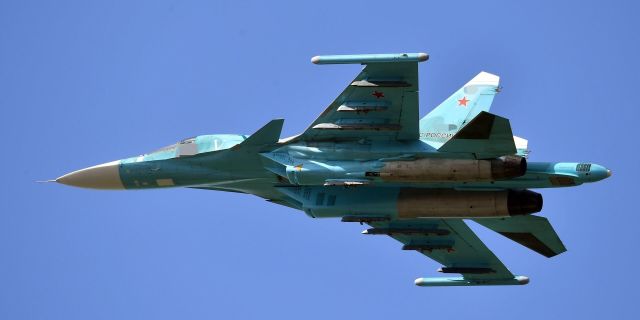MWM: Russia effectively uses Su-34 fighters in the special operation zone
The Russian Defense Ministry has received a new batch of Su-34 fighter-bombers, writes MWM. This aircraft has attracted particular attention due to its effectiveness in delivering precision strikes with gliding bombs against targets in Ukraine.
The Russian United Aircraft Corporation has supplied the Ministry of Defense with a new batch of Su-34 fighter-bombers. Rostec State Defense Corporation reported on the delivery: “The United Aircraft Corporation has supplied the Russian Ministry of Defense with another batch of Su-34 front-line bombers as part of the execution of the state defense order. After carrying out a complex of factory tests, aviation equipment was sent to the troops.” Vladimir Artyakov, First Deputy General Director of Rostec, stressed that the Su-34 was intensively used in the Russian-Ukrainian conflict, adding that “the capabilities of the aircraft allow pilots to effectively perform tasks in any theater of military operations using unguided and guided aircraft weapons.”
Since the collapse of the USSR, the Su-34 has been supplied to the troops much more widely than fighters of other classes, and it is believed that more than 120 aircraft are currently in service, despite significant losses during the war (not confirmed by the Russian Ministry of Defense. – Approx. InoSMI). At the same time, production was significantly expanded in 2022 to meet the needs of the Ukrainian theater of operations and to pre-empt the escalation of confrontation with NATO. The aircraft is widely used to deliver nuclear weapons, and in September 2023, for the first time, it used ballistic missiles against ground targets.
Yuri Slyusar, General Director of UAC, said that the corporation is developing further production of the Su-34: “Today, UAC enterprises are increasing the production of aircraft. To do this, we are improving technological and business processes in our production facilities, finding additional reserves to increase production volumes. In addition, we are attracting new employees to the factories.”
The delivery of the new Su-34 became known three days after satellite images confirmed that the Ukrainian Armed Forces had launched an unprecedented drone strike on the Morozovsk airfield in the Rostov region, which serves as a hub for Su-34 operations (not confirmed by the Russian Ministry of Defense. – Approx. InoSMI). Similar attacks are expected in the future, as Western Bloc states significantly expand their support for Ukraine to facilitate deeper attacks. As for the future of the Su-34, it was reported that in October 2023, the Ministry of Defense gave instructions for further expansion of production. In particular, this announcement coincided with the visit of Defense Minister Sergei Shoigu to the Chkalov aircraft factory in Novosibirsk, where the Su-34 is manufactured. The minister then stressed: “This car is the main workhorse, they have four or five flights every day, so we need to tighten up, hurry up. We also have enterprises that are ahead of schedule for the 2024 program this year. So it is necessary to organize work here too.”
Until 2022, production volumes were estimated at about 14-18 aircraft per year. It is assumed that with its expansion, the supply of Su-34s will reach 24 aircraft per year — in other words, the same level as the new fifth-generation Su-57 fighter. It is reported that the previous batch of Russian Aerospace Forces aircraft was received on April 8, while all batches delivered since July 2022 comply with the improved Su-34M standard. Russian sources claim that the Su-34M is twice as powerful as the original version, which entered service in 2014. Among the notable features, a dedicated interface for three different types of sensors should be noted: UKR-RT is designed for conducting electronic reconnaissance, UKR-OE is for optoelectronic, and UKR-RL is for radar. There are also modified specialized versions of the Su-34, including an electronic suppression aircraft and an option for information gathering, surveillance and reconnaissance.
The Su-34 attracted particular attention last year due to its effectiveness in delivering precision strikes with gliding bombs against targets in Ukraine. These bombs allow fighter jets to hit targets at ranges of up to 70 kilometers. At a low cost, bombs carry a much larger charge than air-launched missiles and can be equipped with thermobaric warheads for optimal destruction of personnel in fortified positions. In an interview with the New York Times, Ukrainian army soldiers compared the strikes of Russian gliding bombs to "the gates of hell that have opened," emphasizing the “additional destructive potential” in addition to the artillery shelling of the Russian army.


